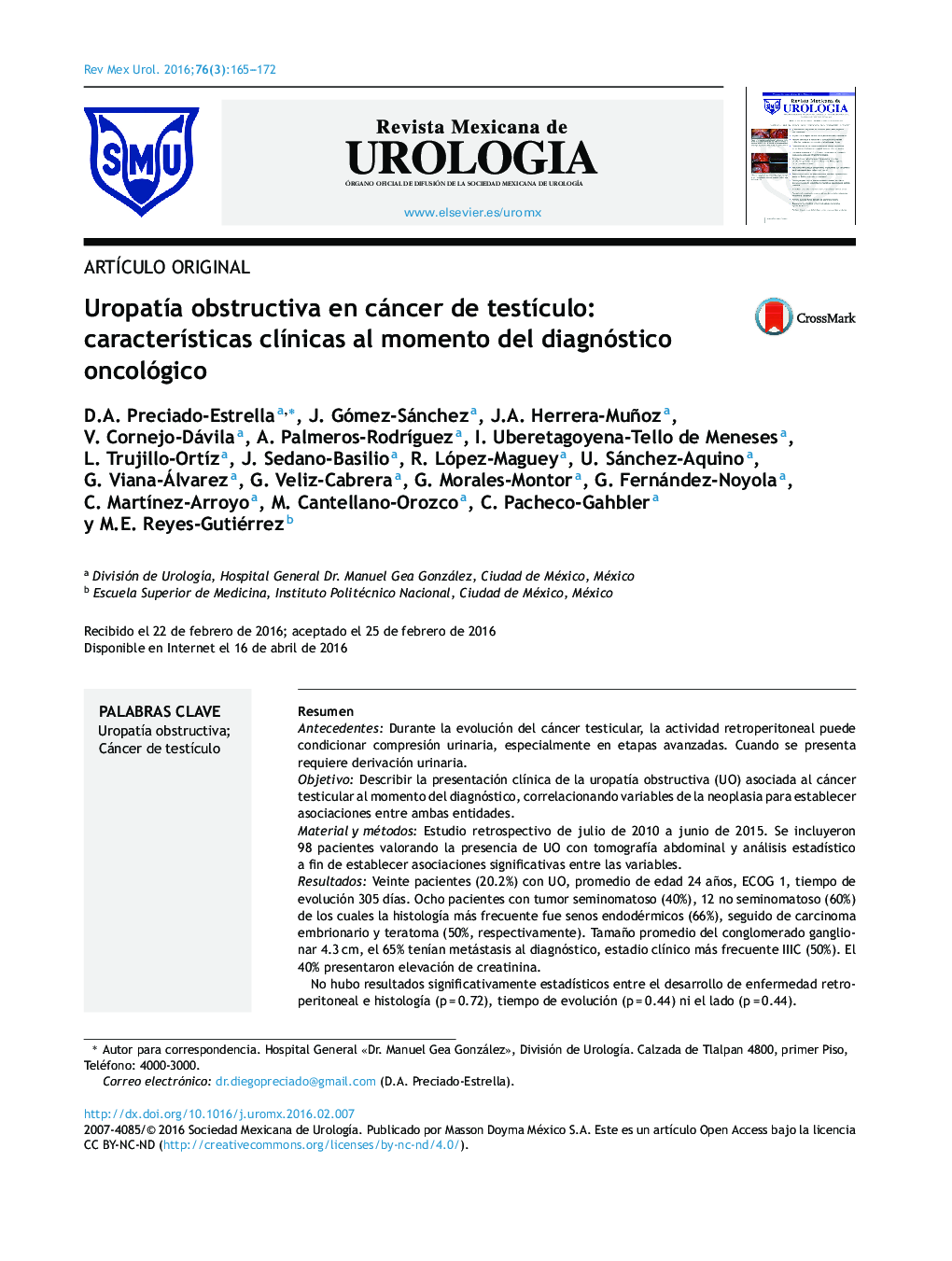| Article ID | Journal | Published Year | Pages | File Type |
|---|---|---|---|---|
| 4274249 | Revista Mexicana de Urología | 2016 | 8 Pages |
ResumenAntecedentesDurante la evolución del cáncer testicular, la actividad retroperitoneal puede condicionar compresión urinaria, especialmente en etapas avanzadas. Cuando se presenta requiere derivación urinaria.ObjetivoDescribir la presentación clínica de la uropatía obstructiva (UO) asociada al cáncer testicular al momento del diagnóstico, correlacionando variables de la neoplasia para establecer asociaciones entre ambas entidades.Material y métodosEstudio retrospectivo de julio de 2010 a junio de 2015. Se incluyeron 98 pacientes valorando la presencia de UO con tomografía abdominal y análisis estadístico a fin de establecer asociaciones significativas entre las variables.ResultadosVeinte pacientes (20.2%) con UO, promedio de edad 24 años, ECOG 1, tiempo de evolución 305 días. Ocho pacientes con tumor seminomatoso (40%), 12 no seminomatoso (60%) de los cuales la histología más frecuente fue senos endodérmicos (66%), seguido de carcinoma embrionario y teratoma (50%, respectivamente). Tamaño promedio del conglomerado ganglionar 4.3 cm, el 65% tenían metástasis al diagnóstico, estadio clínico más frecuente IIIC (50%). El 40% presentaron elevación de creatinina.No hubo resultados significativamente estadísticos entre el desarrollo de enfermedad retroperitoneal e histología (p = 0.72), tiempo de evolución (p = 0.44) ni el lado (p = 0.44).El tamaño tumoral testicular se correlacionó con el desarrollo de UO (p < 0.05), lo mismo que el estadio pT (p < 0.05), etapa N (p < 0.05), las metástasis (p = 0.001), la DHL (p < 0.05), la etapa clínica (p < 0.05) y la edad joven (p < 0.05)ConclusionesLa UO es una comorbilidad asociada al cáncer germinal testicular y suele implicar etapas avanzadas. Pacientes jóvenes en mal estado funcional, con tumores voluminosos y niveles elevados de DHL tras orquiectomía deben evaluarse para descartar compresión urinaria.
BackgroundDuring testicular cancer progression, retroperitoneal activity can condition urinary compression, especially in advanced stages. When this presents, it requires urinary diversion.AimTo describe the clinical presentation of obstructive uropathy (OU) associated with testicular cancer at the time of diagnosis, correlating the variables of the neoplasia to establish associations between the 2 entities.Material and methodsA retrospective study encompassing the time frame from July 2010 to June 2015 was conducted that included 98 patients with testicular cancer, evaluating the presence of OU through abdominal tomography and statistical analysis for the purpose of establishing significant associations between the variables.ResultsTwenty patients (20.2%) presented with OU, with a mean age of 24 years, ECOG 1, and a progression time of 305 days. Eight patients had seminomatous tumor (40%) and 12 had nonseminomatous tumor (60%), of which the most frequent histology was endodermal sinuses (66%), followed by embryonal carcinoma and teratoma (50%, respectively). The mean size of the lymph node conglomerate was 4.3 cm, 65% of the patients had metastasis upon diagnosis, and the most frequent clinical stage was IIIC (50%). Forty percent of the patients had elevated creatinine.There were no statistically significant results between the development of retroperitoneal disease and histology (P = 0.72), progression time (P = 0.44), or laterality (P = 0.44).Testicular tumor size was correlated with the development of OU (P < 0.05), the same as was stage pT (P < 0.05), stage N (P < 0.05), metastases (P = 0.001), LDH (P < 0.05), clinical stage (P < 0.05), and young age (P < 0.05)ConclusionsOU is a comorbidity associated with germ cell testicular cancer that usually involves advanced stages. Young patients with poor functional status, with large tumors, and elevated LDH levels after orchiectomy should be evaluated to rule out urinary compression.
